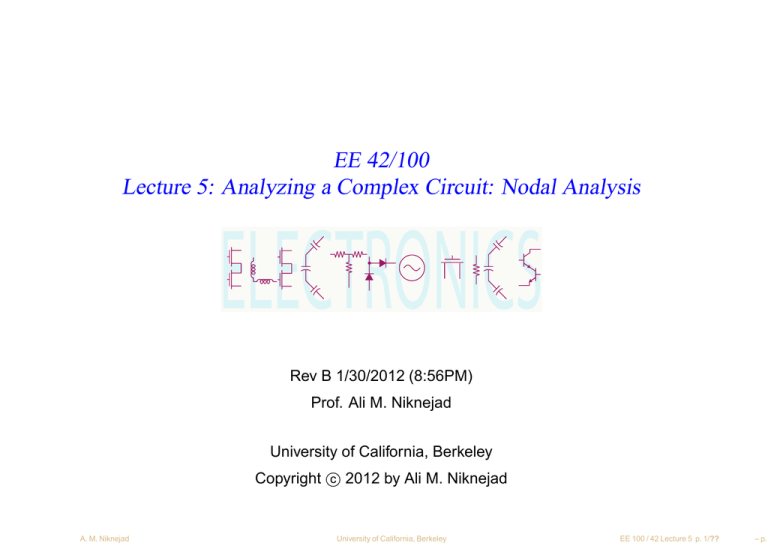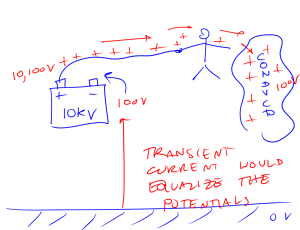ELECTRONICS EE 42/100 Lecture 5: Analyzing a Complex Circuit: Nodal Analysis
advertisement

EE 42/100 Lecture 5: Analyzing a Complex Circuit: Nodal Analysis ELECTRONICS Rev B 1/30/2012 (8:56PM) Prof. Ali M. Niknejad University of California, Berkeley c 2012 by Ali M. Niknejad Copyright A. M. Niknejad University of California, Berkeley EE 100 / 42 Lecture 5 p. 1/?? – p. Analyzing a Complex Network + + • Simple circuit can be solved using repeated applications of series-parallel formulas and current/voltage dividers (left schematic). Next lecture we’ll learn a few more tricks to add to our toolbox. • For now we’d like to develop a systematic methodology to solve for the currents and voltages (and hence power) in any arbitrary circuit (right schematic). • Nodal Analysis: Repeated application of KCL to each node of the circuit. It can be used to solve for all of the voltages (and subsequently currents) in the circuit. This will be our prime analysis technique in this class. • Mesh and Loop Analysis: Repeated application of KVL can be used to find the currents (and subsequently voltages) in a circuit. In this class we will not use mesh/loop analysis. A. M. Niknejad University of California, Berkeley EE 100 / 42 Lecture 5 p. 2/?? – p. Identifying the Reference Node Vj Vk + Vgnd = 0 • Recall that voltage is defined as a quantity that measures the potential difference between two nodes in a circuit, VAB . • We can arbitrarily pick one node of the circuit and define all node voltages in reference to this node. Call this node ground, or node ‘0’. In other words, define Vk as the node voltage at node k which is the energy gained per unit charge as it moves from node gnd to node k, or in more cumbersome notation, Vk,gnd . • If we subtract the two node voltages, we get Vj,gnd − Vk,gnd = Vj − Vgnd − (Vk − Vgnd ) = Vj − Vk = Vj,k • In other words Vj,k = Vj,gnd − Vk,gnd , which makes sense since they are defined with respect to the same reference. Note that the reference potential is by definition at zero potential, Vgnd = 0. A. M. Niknejad University of California, Berkeley EE 100 / 42 Lecture 5 p. 3/?? – p. Node Equations for Resistive Branches Vj I1 Rx Vk I2 Ix I3 • Since the potential at the ground node is known, only n − 1 unknown node voltages remain. Writing KCL at each other node results in an equation in the following form I1 + I2 − I3 + Ix = 0 • In a resistive branch, the current can be written in terms of the node voltages. If current Ik flows from node a to node b, it’s given by Ix = • Vk − Vj = Gx (Vk − Vj ) Rx If an independent current source is connected to the node, then the current is known. A. M. Niknejad University of California, Berkeley EE 100 / 42 Lecture 5 p. 4/?? – p. KCL Example 1 R5 is R2 R1 R3 + vs R4 • We are now in a position to solve many circuit problems. For example, in the above circuit we proceed as follows. • First we choose the reference ground potential at the negative terminal of the voltage source. Why? Because then we eliminate one unknown node voltage from the circuit. The node connected to the positive terminal of the source is at a voltage of vs . • We have eliminated two nodes from the list of unknowns. Now there are only two nodes left in the circuit. A. M. Niknejad University of California, Berkeley EE 100 / 42 Lecture 5 p. 5/?? – p. KCL Example 1 R5 is R2 R1 R3 + vs R4 • We are now in a position to solve many circuit problems. For example, in the above circuit we proceed as follows. • First we choose the reference ground potential at the negative terminal of the voltage source. Why? Because then we eliminate one unknown node voltage from the circuit. The node connected to the positive terminal of the source is at a voltage of vs . • We have eliminated two nodes from the list of unknowns. Now there are only two nodes left in the circuit. A. M. Niknejad University of California, Berkeley EE 100 / 42 Lecture 5 p. 5/?? – p. Example 1 KCL Equations R5 is R2 R1 A. M. Niknejad R3 + vs University of California, Berkeley R4 EE 100 / 42 Lecture 5 p. 6/?? – p. KCL Example 1 (cont) • For each node we write KCL equations. We setup two equations with two unknowns. • It’s good to write these equations in standard form. Put the unknowns on the left hand side and the known currents (due to the independent sources) on the right hand side. Then we have a matrix equation Av = b which we solve by matrix inversion (Gaussian elimination, Cramer’s rule, matlab, etc.) v = A−1 b A. M. Niknejad University of California, Berkeley EE 100 / 42 Lecture 5 p. 7/?? – p. Dealing with “Floating" Voltage Sources Vs + B R2 A + V R1 s R3 R5 R4 R6 • In the above example, two voltage sources appear so that we cannot label both negative terminals as ground. So we pick one. • In this circuit, the number of unknowns is smaller because if we know the voltage at one node connected to the voltage source, the voltage at the other has a fixed relation, since VAB = Vs . • But in writing down KCL at one of the nodes, we encounter a problem. The current through the voltage source can take on any value, which means that other circuit elements determine the current through it. A. M. Niknejad University of California, Berkeley EE 100 / 42 Lecture 5 p. 8/?? – p. KCL at a “Super Node" + Vs R2 + V R1 s Is R3 I2 I R5 I4 R4 R6 I1 • But note that if we write the KCL equations for both terminals of the voltage source, this unknown current appears twice. At the positive terminal:I1 + I2 + I3 + Is = 0 At the negative terminal: I4 − Is = 0 • If we add these two equations, Is cancels out I1 + I2 + I3 + I4 = 0 • This is an independent equation we can use. It’s actually KCL for a “super node", which is what we call nodes a and b together. We have just shown that current continuity applies to a node and also to a super node. A. M. Niknejad University of California, Berkeley EE 100 / 42 Lecture 5 p. 9/?? – p. KCL Example 2 (Super Node) + Vs R2 + V R1 s • R3 R5 R4 R6 Using the steps that we have learned, we first identify a ground node at a convenient location (negative terminal of a source). Then we identify two super nodes in the circuit. For each super node we write KCL, put the equation into standard form, and solve. A. M. Niknejad University of California, Berkeley EE 100 / 42 Lecture 5 p. 10/?? –p Elimination Trivial Nodes + Vs R2 + V R1 s R3 R5 R4 R6 • Any node with less that three elements is in some sense trivial. That’s because we can find the node voltage for such a node from the branch current. Thus, it’s smart to avoid writing equations for these nodes and to deal with them later. • In the above example the number of unknowns has been reduced from 2 to 1 by using this technique A. M. Niknejad University of California, Berkeley EE 100 / 42 Lecture 5 p. 11/?? –p Dependent Sources Ix = KVR2 Vj + V R1 s R2 V k +VR2 − R3 R5 R4 R6 • Dependent sources require a bit more work but are generally dealt with in the same way. In the above circuit we initially treat the current through the dependent source as an unknown in writing KCL. • There are now more unknowns than equations. For each additional unknown (dependent current), we can write an additional equation which relates the dependent current to the node voltages. For instance, for a VCCS, this is trivial Ix = KVR2 = K(Vj − Vk ) A. M. Niknejad University of California, Berkeley EE 100 / 42 Lecture 5 p. 12/?? –p Dependent Source (cont) Ix = IR2 Vj + V R1 s • R2 V k IR2 R3 R5 R4 R6 For a CCCS, we simply need to calculate the current Ix = JIR2 = J(Vj − Vk )/R2 • Instead of making life more complicated by introducing new equations, we should actually just eliminate the unknown currents from our original set of equations. In other words, substitute the above equations for Ix and Iy , in our original n − 1 node equations. A. M. Niknejad University of California, Berkeley EE 100 / 42 Lecture 5 p. 13/?? –p Dependent Voltage Source + Vs R2 KVR4 • + R1 R3 R5 + VR4 − R4 R6 Nodes with dependent voltage sources are handled in the same way. They can also form supernodes and a KCL equation can be written for the supernode, just like independent sources. The only difference is that the potential difference between the floating dependent voltage source is not known until all the equations are solved. A. M. Niknejad University of California, Berkeley EE 100 / 42 Lecture 5 p. 14/?? –p Dependent Voltage Source + Vs R2 KVR4 • + R1 R3 R5 + VR4 − R4 R6 Nodes with dependent voltage sources are handled in the same way. They can also form supernodes and a KCL equation can be written for the supernode, just like independent sources. The only difference is that the potential difference between the floating dependent voltage source is not known until all the equations are solved. A. M. Niknejad University of California, Berkeley EE 100 / 42 Lecture 5 p. 14/?? –p KCL Example 3 (Dependent I Source) Ix = KVR2 Vj + V R1 s R2 V k +VR2 − R3 R5 R4 R6 • In this example we start as always by defining the reference ground node, and then by writing node equations for all the remaining nodes. • The only wrinkle is that the dependent current source, which introduces an extra unknown. To eliminate this extra unknown, we write additional equations expressing the unknown current in terms of the remaining node voltages. A. M. Niknejad University of California, Berkeley EE 100 / 42 Lecture 5 p. 15/?? –p KCL Example 4: (Dependent V Source) + Vs R2 KVR4 • + R1 R3 R5 + VR4 − R4 R6 This example involves a dependent voltage source. The solution procedure is nearly identical to the case without the dependent source, except that we write the auxiliary equation to eliminate the additional unknowns. A. M. Niknejad University of California, Berkeley EE 100 / 42 Lecture 5 p. 16/?? –p





